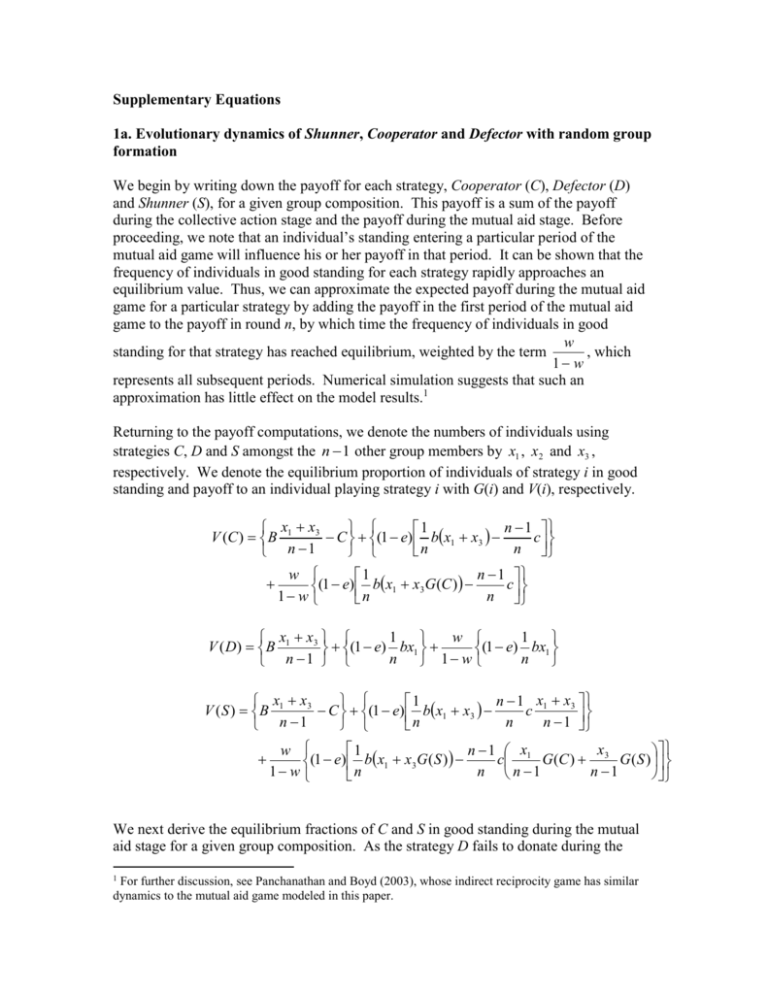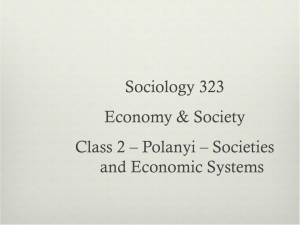Supplementary Equations - Word file (436 KB )
advertisement

Supplementary Equations 1a. Evolutionary dynamics of Shunner, Cooperator and Defector with random group formation We begin by writing down the payoff for each strategy, Cooperator (C), Defector (D) and Shunner (S), for a given group composition. This payoff is a sum of the payoff during the collective action stage and the payoff during the mutual aid stage. Before proceeding, we note that an individual’s standing entering a particular period of the mutual aid game will influence his or her payoff in that period. It can be shown that the frequency of individuals in good standing for each strategy rapidly approaches an equilibrium value. Thus, we can approximate the expected payoff during the mutual aid game for a particular strategy by adding the payoff in the first period of the mutual aid game to the payoff in round n, by which time the frequency of individuals in good w standing for that strategy has reached equilibrium, weighted by the term , which 1 w represents all subsequent periods. Numerical simulation suggests that such an approximation has little effect on the model results.1 Returning to the payoff computations, we denote the numbers of individuals using strategies C, D and S amongst the n 1 other group members by x1 , x2 and x3 , respectively. We denote the equilibrium proportion of individuals of strategy i in good standing and payoff to an individual playing strategy i with G(i) and V(i), respectively. n 1 x x3 1 V (C ) B 1 C (1 e) bx1 x3 c n n n 1 w n 1 1 c (1 e) bx1 x3G (C ) 1 w n n 1 w 1 x x3 V ( D) B 1 (1 e) bx1 (1 e) bx1 n n 1 w n 1 n 1 x1 x3 x x3 1 V (S ) B 1 C (1 e) bx1 x3 c n n 1 n 1 n 1 x w n 1 x1 c G (C ) 3 G ( S ) (1 e) b x1 x3G ( S ) 1 w n n 1 n 1 n We next derive the equilibrium fractions of C and S in good standing during the mutual aid stage for a given group composition. As the strategy D fails to donate during the 1 For further discussion, see Panchanathan and Boyd (2003), whose indirect reciprocity game has similar dynamics to the mutual aid game modeled in this paper. collective action stage, it immediately falls into bad standing and never recovers. We denote the fraction of strategy i in good standing during round n by g n (i) . The term g n denotes the total fraction of a social group in good standing during round n. n 1 1 n 1 g n (C ) g n 1 (C ) (1 g n 1e) (1 g n 1 (C )) (1 e) n n n n 1 1 n 1 g n ( S ) g n 1 ( S ) (1 g n 1e) (1 g n 1 ( S )) g n (1 e) n n n To derive G(C) and G(S), we assume that e is small such that e 2 0 . Further, as simulation results indicate that G (C ) 1 , we can assume that G(C ) 2 2G(C ) 1 . At x x equilibrium, we have G (C ) 1 e 1 3 and G ( S ) 1 e . n 1 The expected fitness of a strategy is the payoff off that strategy in a given group averaged over all possible group compositions. If we let p, q and 1 p q denote the frequencies of S, C and D, respectively, in the global population, then, from the properties of the multinomial distribution, the expected values of x1 , x2 and x3 are q(n 1) , (1 p q )( n 1) and p ( n 1) , respectively. Substituting these expectations, we find the expected fitness for each type is 1 e n 1 b(q p(1 we( p q))) c 1 w n 1 e n 1 W ( D) W0 B(q p) bq 1 w n 1 e n 1 W ( S ) W0 B(q p ) C b(q p(1 we)) c(q(1 we( p q)) p(1 we)) 1 w n W (C ) W0 B(q p ) C where W0 represents baseline fitness. When Shunner is common, the fitness of all three strategies will be dominated by groups in which the other n – 1 individuals are Shunner. Thus, to determine when Shunner can resist invasion by rare Defectors, we set q 0 and p 1 . We then find that W ( S ) W ( D ) when 1 e n 1 (b c)(1 we) C 1 w n This conditions tells us that Shunner is evolutionarily stable against Defector when the long run benefits of reciprocity through mutual aid (the expression on the left of the inequality) is greater than the short-term benefit of free riding the collective action (the expression on the right). Next, to find the stability criteria for Shunner against Cooperator, we begin by setting 1 p q 0 and p 1 . We then find the condition under which W ( S ) W (C ) to be cwe 0 This tells us that so long mutual aid (1) is costly, (2) persists for more than one period, and (3) is prone to error, then Shunner is an ESS against Cooperator. 1b. Invasion analysis of Shunner against Defector assuming non-random group formation Setting the frequency of Cooperator (q) to zero, we model this condition by assuming that the conditional probability of a type j donor matched with a type i recipient during the mutual aid game, Pr(i | j ) , is: Pr( S | S ) r (1 r ) p Pr( D | S ) (1 r )(1 p) Pr( S | D) (1 r ) p Pr( D | D ) r (1 r )(1 p ) The parameter r is the coefficient of relatedness in a haploid sexual genetic model and, more generally, measures the degree of assortment. It then follows that the expected number of type j individuals amongst the other n 1 group members in a group containing one individual of type i, which we denote by ( x j | i ) , is: ( x3 | S ) (r (1 r ) p)(n 1) ( x2 | S ) (1 r )(1 p)(n 1) ( x3 | D) (1 r ) p(n 1) ( x2 | D) (r (1 r )(1 p))(n 1) Substituting these expectations we have the following fitness functions: W ( D) W0 B(1 r ) p W ( S ) W0 B(r (1 r ) p) C 1 e n 1 (b c)(1 we)(r (1 r ) p) 1 w n As Shunner and Defector are evolutionarily stable against invasion by each other, we can find the unstable equilibrium by setting the two fitness functions equal to each other. The expression for the unstable equilibrium, plotted in Figure 3a of the text, is given by 1 e n 1 C r B (b c)(1 we) 1 w n pˆ 1 w n 1 (b c)(1 we)(1 r ) 1 e n To determine threshold amount of assortment (r*) necessary for Shunner to invade against Defector, we set p 0 and find the conditions under which W ( S ) W ( D ) , solving for r. , 1 e n 1 r * B (b c)(1 we) C 1 w n This critical threshold of relatedness is plotted in Figure 2a of the text. To get a better sense of what this expression means, we can simplify by assuming that (1) there are no errors to mutual aid contribution (i.e., e 0 ) and (2) groups are large (i.e., n 1 1 ). These assumptions do not alter the results qualitatively. We now have n b c r * B C 1 w This expression can be rewritten as B(1 w) (b c) r* C 1 w This condition bears striking similarity to the condition for the invasion of Tit-for-tat against Defector in the model of reciprocal altruism studied by Axelrod and Hamilton (1981). This is not surprising as the mutual aid game we study here, Axelrod and Hamilton’s model of reciprocal altruism, and models of indirect reciprocity (Nowak and Sigmund 1998; Panchanathan and Boyd 2003) are all systems of reciprocity and thus have similar dynamical properties. Thus, as with other models of reciprocity, relatedness and reciprocity operate synergistically, such that an increase in w results in a lowered requisite value of r* for the evolution of cooperation. Conversely, an increase in assortment (r*) leads to a decrease in the requisite number of reciprocity bouts (w). This relationship can be shown by taking the derivative of r* with respect to w. When we do this, we find that r * 0 w 2. Evolutionary dynamics of Shunner and Reciprocator with non-random group formation In this model, we consider two strategies: Shunner (S) and Reciprocator (R). In this model, R types do not contribute to the collective action and do not attend to whether others do while S types contribute and attend to others’ contributions. We keep track of the number of S and R amongst the n 1 other group members with x3 and x4 , respectively. And we keep track of the global frequency S and R with p and 1 p , respectively. Using the binomial theorem and the previously-defined assortment parameter (r), we have: Pr1 Pr( S | S ) r (1 r ) p Pr2 Pr( R | S ) (1 r )(1 p) Pr3 Pr( S | R) (1 r ) p Pr4 Pr( R | R) r (1 r )(1 p ) and 1 ( x3 | S ) (r (1 r ) p)(n 1) 2 ( x4 | S ) (1 r )(1 p)(n 1) 3 ( x3 | R) (1 r ) p(n 1) 4 ( x4 | R) (r (1 r )(1 p))(n 1) To determine the equilibrium fraction of individuals in good standing for each type, we note that while both S and R attend to standing, they each have different rules for its assignment. As such, we let g n (i | j ) be the fraction of type i in good standing in round n as seen by type j. As Reciprocator does not participate in the collective action, gn ( R | S ) 0 for all rounds after stage one, leaving us with the following recursions: gn (S | S ) 1 n 1 g n 1 (S | S )(Pr1 (1 g n 1 (S | S )e) Pr2 (1 g n 1 ( R | S )e)) g n 1 (S | S ) n n (1 g n 1 ( S | S ))(Pr1 g n 1 ( S | S )(1 e) Pr2 g n 1 ( R | S )(1 e)) g n ( R | R) 1 n 1 g n 1 ( R | R)(Pr3 (1 g n 1 (S | R)e) Pr4 (1 g n 1 ( R | R)e)) g n 1 ( R | R) n n (1 g n 1 ( R | R))(Pr3 g n 1 (S | R)(1 e) Pr4 g n 1 ( R | R)(1 e)) g n1 ( S | R)g n1 ( S | R) g n1 ( S | S )(1 e) (1 g n1 ( S | R) 1 n 1 Pr1 g n ( S | R) g n1 ( S | R) (1 g n1 ( S | R)) g n1 ( S | S )(1 e) n n Pr g ( S | R)(1 g ( R | R)) 2 n 1 n 1 At equilibrium, we have G(R | S ) 0 G(S | S ) 1 e G ( R | R) 1 e G ( S | R ) Pr1 (1 2e) Using a similar method outlined for model one, we derive expected fitness functions for each strategy. 1 e n 1 b 1 w w Pr1[(1 e) Pr2 (1 2e)] c Pr1 (1 we) 1 w n 1 e n 1 b Pr4 (1 we) c 1 w w Pr3 Pr1 (1 2e) Pr4 (1 e) W ( R ) W0 B (1 r ) p 1 w n W ( S ) W0 B r (1 r ) p C By setting these fitness functions equal to each other, we can find any internal equilibrium points. The result is a quadratic function given by 1 e n 1 w(1 r ) 2 (1 2e)(b c) 1 w n 1 e n 1 pˆ (1 r )b1 2w(1 2e)(1 r ) c1 w(1 2e)(1 r ) 1 w n 1 e n 1 C Br bwr 2 (1 2e) r (2 3e) (1 e) c(1 r )(1 we) 0 1 w n pˆ 2 The negative root of this expression lies between [0, 1] and is an unstable equilibrium. It is graphed in Figure 3b of the text. To determine the stability criteria for Reciprocator, we set p 0 and r 0 and then solve for W ( R) W ( S ) , which yields the condition 1 e n 1 bw(1 e) c(1 we) C 0 1 w n We next investigate the conditions under which Shunner can invade a population playing Reciprocator. We set p 0 and find the conditions under which W ( S ) W ( R) . This results in a critical minimum threshold of relatedness (r*) for Shunner to invade against Reciprocator, which is given by 1 e n 1 1 e n 1 bw(2 3e) c(1 we) (r*)2 bw(1 2e) r * B 1 w n 1 w n 1 e n 1 bw(1 e) c(1 we) 0 C 1 w n This critical threshold of relatedness is plotted in Figure 2b of the text. As we are interested in invasion conditions for which r* is small, we can assume that (r*)2 0 . We now have 1 e n 1 bw(2 3e) c(1 we) C 1 e n 1 bw(1 e) c(1 we) 0 r * B 1 w n 1 w n As in the previous section, we set e 0 and n 1 1 , which leaves us with the condition n 2bw c bw c r * B C 1 w 1 w From this inequality, it is not obvious how assortment (r*) and reciprocity (w) interact. Thus, we take the derivative of r* with respect to w, which yields r * B(b c) C (2b c) bc w B(1 w) 2bw c2 As the denominator is positive, we can write r * B(b c) C (2b c) bc w It is not clear whether this expression is positive or negative. Let us, therefore, momentarily assume that there is no cost to contributing to the collective action. This seems a safe assumption as it represents the most conducive condition for the invasion of the Shunner strategy. In a moment, we will relax this assumption. By setting C 0 , we now have r * B(b c) bc w As this expression is positive, we observe that relatedness and reciprocity operate antagonistically. This result is in stark contrast to the one derived in section 1b and that of Axelrod and Hamilton’s model of reciprocal altruism. If the Shunner type is to invade, it can only be driven by inclusive benefits from the collective action. As the importance of reciprocity (w) increases, the requisite assortment level (r*) increases. How safe is it to analyze the relationship between assortment (r*) and reciprocity (w) when the collective action is costless ( C 0 )? Above we found that r * B(b c) C (2b c) bc w r * 0 ), reciprocity and inclusive fitness operate w antagonistically. This derivative will be positive when the collective action benefit (B) is sufficiently high. Precisely, When this derivative is positive ( B Under most model parameter values, C (2b c) bc bc r * 0 when B 3C (Figure 4). w Figure 4. The minimum threshold of collective action benefit ( B and reciprocity to operate antagonistically ( C ) necessary for Relatedness r * 0 ) as a function collective action cost (C) and w cost benefit ratio of mutual aid ( b ). The cost of cooperating during one bout of mutual aid (c) is c set to 1. Surprisingly, this says that when the collective action is sufficiently group beneficial ( B 3C ), increasing the strength of reciprocity (w) increases the requisite relatedness threshold for Shunners to invade against Reciprocity (r*). Why would a less group beneficial collective action make it easier for Shunners to invade? From Figure 4, we see r * 0 , when B C . In Figure 5, we plot the threshold relatedness (r*) when that w B C. (a) (b) Figure 5. The threshold degree of assortment ( r*) necessary for rare Shunners to invade a population in which Reciprocators are common as a function of the number of mutual aid periods ( 1 ) for different costs and benefits of collective action (B, C). In (a), b 2 and in (b), 1 w b 4 . In both (a) and (b), c 1 , n 30 and e 0.01. From this figure we see that the threshold relatedness does in fact decrease as the strength r * 0 ). This implies that relatedness and reciprocity operate of reciprocity increases ( w synergistically (i.e., Axelrod and Hamilton’s “ratchet”). Notice, however, that the threshold relatedness in Figure 5 approaches an asymptote which never falls below 0.5. If we are interested in a model of human social behavior, these regions of the parameter space are biologically uninteresting. Thus, we can say that under relevant parameter r * 0 seems to hold. values our assertion that w 3. Evolutionary dynamics of two types of Shunner with non-random group formation In this section, which was not presented in the text, we investigate how social norms change in our social model. Thus, we have two strategies: Shunner Type 1 (S1) and Shunner Type 2 (S2). S1 contributes to collective action 1 at a private net cost of C1 , which produces a benefit B1 which is shared amongst the n 1 other group members. This strategy assigns a lifetime of bad standing to those that do not contribute to this collective action. S2 contributes to collective action 2 with associated costs and benefits C2 and B2 , respectively. S2 assigns a lifetime of bad standing to those that do not contribute to this collective action. We keep track of the number of S1 and S2 amongst the n 1 other group members with n 1 x and x , respectively. And we keep track of the global frequency S1 and S2 with 1 p and p, respectively. Using the binomial theorem and the previously-defined assortment parameter (r), we have: Pr1 Pr( S 2 | S 2) r (1 r ) p Pr2 Pr( S1 | S 2) (1 r )(1 p) Pr3 Pr( S 2 | S1) (1 r ) p Pr4 Pr( S1 | S1) r (1 r )(1 p) and 1 ( x | S 2) (r (1 r ) p)(n 1) 2 (n 1 x | S 2) (1 r )(1 p)(n 1) 3 ( x | S1) (1 r ) p(n 1) 4 (n 1 x | S1) (r (1 r )(1 p))( n 1) As in the previous section, S1 and S2 both attend to standing but have different assignment rules. As before, we let g n (i | j ) be the fraction of type i in good standing in round n as seen by type j. As S1 and S2 do not contribute to the collective action which the other strategy expects, we have g n ( S1 | S 2) 0 and g n ( S 2 | S1) 0 for all rounds after stage one, leaving us with the following two recursions: g n (S1 | S1) 1 n 1 gn 1 (S1 | S1)(Pr4 (1 g n 1 (S1 | S1)e) Pr3 (1 g n 1 (S 2 | S1)e)) gn 1 (S1 | S1) n n (1 g n 1 (S1 | S1))(Pr4 gn 1 (S1 | S1)(1 e) Pr3 g n 1 (S 2 | S1)(1 e)) g n ( S 2 | S 2) 1 n 1 g n1 ( S 2 | S 2)(Pr1 (1 g n1 ( S 2 | S 2)e) Pr2 (1 g n1 ( S1 | S 2)e)) g n1 ( S 2 | S 2) (1 g ( S 2 | S 2))(Pr g ( S 2 | S 2)(1 e) Pr g ( S1 | S 2)(1 e)) n n n1 1 n1 2 n1 At equilibrium, we have G ( S1| S1) 1 e G ( S 2 | S1) 0 G ( S1| S 2) 0 G ( S 2 | S 2) 1 e Using a similar method outlined for model one, we derive expected fitness functions for each strategy. 1 e n 1 (b c)(1 we) r (1 r )(1 p) 1 w n 1 e n 1 W ( S 2) W0 B2 r (1 r ) p C2 B1 (1 r )(1 p ) (b c)(1 we) r (1 r ) p 1 w n W ( S1) W0 B1 r (1 r )(1 p ) C1 B2 (1 r ) p To determine the stability criteria for S1, we set p 0 and r 0 and then solve for W ( S1) W ( S 2) , which yields the condition 1 e n 1 (b c)(1 we) C2 C1 1 w n We next investigate the conditions under which S2 can invade a population playing S1. We set p 0 and find the condition under which W ( S 2) W ( S1) , which results in a critical minimum threshold of relatedness (r*) for S2 to invade against S1. 1 e n 1 1 e n 1 r * B2 B1 (b c)(1 we) C2 C1 (b c)(1 we) 1 w n 1 w n As in the previous section, we set e 0 and n 1 1 , which leaves us with the condition n b c b c r * B2 B1 C2 C1 1 w 1 w From this inequality, it is not obvious how assortment and reciprocity interact. Thus, we take the derivative of r* with respect to w, which yields r * (b c)( B2 C2 ) ( B1 C1 ) w ( B2 B1 )(1 w) (b c)2 As the denominator is positive, we can write r * (b c)( B2 C2 ) ( B1 C1 ) w This says that relatedness and reciprocity operate antagonistically when the new social norm increases mean fitness compared to the old social norms (i.e., B2 C2 B1 C1 ). That is, under such conditions, the invasion of S2 is only determined by the inclusive benefits from the collective action. As the effect of reciprocity increases (i.e., w increases), the requisite assortment (i.e., r*) increases. Note that above condition also implies that relatedness and reciprocity operate synergistically, which occurs when the new social norm decreases mean fitness (i.e., B1 C1 B2 C2 ). Simulation results indicate, however, that this result is misleading; the synergy between assortment and reciprocity only occurs under conditions not otherwise conducive to the evolution of cooperation. REFERENCES CITED Axelrod, R. and W. D. Hamilton (1981). "The evolution of cooperation." Science 211: 1390-1396. Nowak, M. A. and K. Sigmund (1998). "The dynamics of indirect reciprocity." Journal of Theoretical Biology 194(4): 561-574. Panchanathan, K. and R. Boyd (2003). "A tale of two defectors: the importance of standing for the evolution of indirect reciprocity." Journal of Theoretical Biology 224: 115-126.







